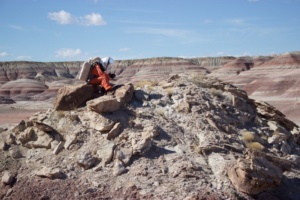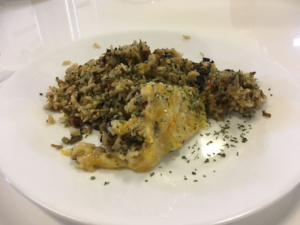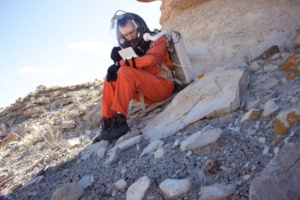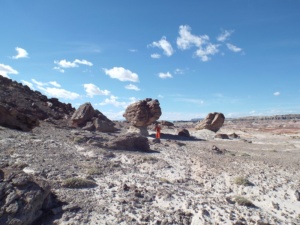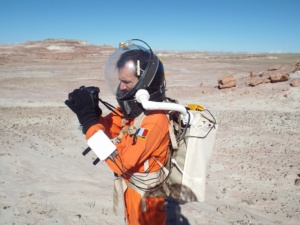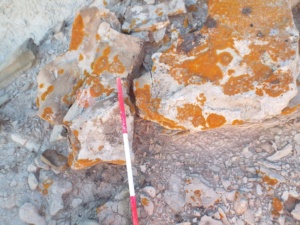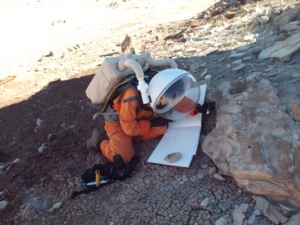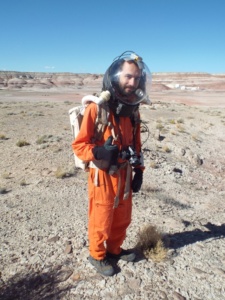Sol Journal – October 29th
THE PODS
Jon Clarke
A wheezing, groaning sound fills the lower deck of MDRS and an upright blue box materialises in the EVA prep room. A tall, distinguished-looking, grey-haired man with attack eyebrows emerges, followed by a short, frizzy-haired young woman. He looks round quizzically. “Ah, yes, the early 21st century Mars simulation in the Utah desert” he said in a Scots accent. “They practiced how to live and work on Mars in this for many years before actually sending people there. Of course, had they paid more attention to water purification, the whole Bowie Base debacle wouldn’t have happened.” The young woman looked unimpressed. “Is that a rat I see? Maybe they should pay more attention fixing holes in the wall.”
Voices yell upstairs “We have uninvited visitors AGAIN!”,“Maybe those Russians are back?”, “Can someone get rid of them?” Two scruffy-looking individuals clatter down the stairs. “What are you doing here? Didn’t you see the PRIVATE PROPERTY signs? We put them up just the other day.”
The grey-haired man snorts. “I never pay attention to those. Besides, we didn’t come through the door.” He flashes an ID: “Here are my credentials”. The rest of the crew members come down the stairs and peer at them. “So you are from Roskosmos” says the Russian. “And from CSA, just up the road” murmurs the Canadian. The Indian crew member adds excitedly “ISRO too!” The commander scratches his scruffy beard and raises his Gallic eyebrows; CNES and ESA?” The frizzy-haired woman smirks: “Gets them every time, Dr.” The two Australian look disgusted “It’s blank!” they say. The Japanese crew member smiles enigmatically, thinking about his own cabin in the station that’s bigger on the inside.
Their visitors peer at the various pods scattered round. They are brightly lit, have numerous electronic connections, flashing monitors, and emit occasional beeps and gurgling sounds. Plants grow out of them, trailing tendrils everywhere. “What’s this then? Plants and technology? Asks their older visitor, “That did not end well on the Byzantium”. “The crew days “We are studying the interaction between the crew and the plants. The system monitors our stress levels and tells us when to feed and water the plants”.
“How does the system know your stress state?” asks the frizzy-haired woman, “through those?” She points at blinking wrist-watch like instruments. “That’s right”, says one crew member, more grizzled than the rest, “I even have two pods in my cabin to look after”. Their older visitor rolls his eyes. “Plants controlling people, don’t you remember the Crinoid? They crew look blank. “Doesn’t anyone read the older literature these days? You’ll wake up one morning with as cyber plant zombies with tendrils through your brains, if you’re not careful. It won’t be pretty. Really, humanity’s ability to invent new ways to destroy itself borders on genius!” The Japanese crew member smiled; “Don’t worry Dr; the technology is not from Cybus Industries this time”.
Their older visitor shrugs “Oh well, be it on your own heads, we will be off then. Be careful of the carrots too. Growing them might help your water supply but could be more trouble than they are worth.” The woman goes into the blue box, followed by the man. He pauses at the doorway to the brightly lit interior of the blue box, sniffs, and looks narrowly into the corners. “There’s lots of dust in the air here. Stay out of the shadows”. The door closes behinds him, a blue light starts to flash and the box dematerialises amid a wheezing and groaning as of brakes left on. The crew stand in silence for a while. “We’ve had odder visitors” the commander says at last.




